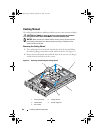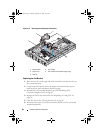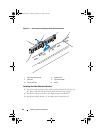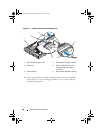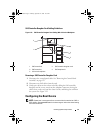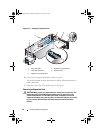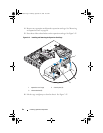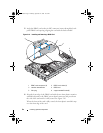
88 Installing System Components
If you plan to boot the system from a hard drive, the drive must be attached to
the primary (or boot) controller. The device that the system boots from is
determined by the boot order specified in the System Setup program
.
The System Setup program provides options that the system uses to scan for
installed boot devices. See "Using the System Setup Program" on page 45 for
information about the System Setup program.
Expansion Cards
The system is available with a PCI Express (PCIe) left riser board option. The
PCIe left riser board provides one PCIe x8-lane expansion slot and one PCIe
x4-lane expansion slot. The half-height center riser board provided with the
PCIe left riser board option features one PCIe x8-lane expansion slot. The
three expansion card slots are on separate buses.
Expansion Card Installation Guidelines
To identify expansion slots, see "Expansion-Card Riser-Board Components
and PCI Buses" on page 162.
NOTE: The expansion-card slots are not hot-pluggable.
NOTE: Although the PCIe x4-lane expansion slot on the PCIe left riser option is
physically a PCIe x8 connector, it functions only as a PCIe x4-lane slot.
NOTE: Slot 1 on the central riser supports half-length expansion cards only. Slots 2
and 3 on the left riser support full-length expansion cards.
NOTE: Your system supports up to two RAID expansion cards to manage external
storage.
Installing an Expansion Card
CAUTION: Many repairs may only be done by a certified service technician. You
should only perform troubleshooting and simple repairs as authorized in your
product documentation, or as directed by the online or telephone service and
support team. Damage due to servicing that is not authorized by Dell is not covered
by your warranty. Read and follow the safety instructions that came with the
product.
Book.book Page 88 Monday, September 14, 2009 12:57 PM



